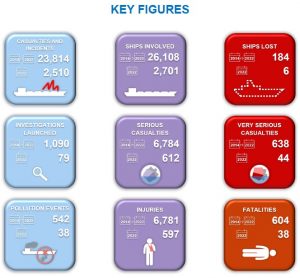The figures from EMCIP database cover the period from 1st of January 2014 to 31st of December 2022.
To draw objective comparisons between the different ship types, ratios between the number of marine casualties and incidents involving each ship type and its corresponding fleet size were calculated. These ratios are called ship occurrence indicators and show the number of marine casualties and incidents in one year per one thousand ships.
The average ship occurrence indicator in the period from 2014 to 2022 was 115, with a maximum of 125 in 2019, a minimum of 101 in 2020 and 109 in 2022. Both passenger ships and cargo ships had the greater average ship occurrence indicators, 211 and 152 respectively. Indicators in 2022 are stabilised in comparison with the previous year. Regarding service ships, this category had the lowest indicator, with an average of 44 over the period from 2014 to 2022. Finally, the occurrence indicator about fishing vessels was 51 with an increase over the period from 2014 to 2022. 
From 2014 to 2022, ‘internal waters (port area and other)’ were the locations where more than half of the reported marine casualties and incidents took place, followed by ‘Territorial sea’ and ‘Open sea’. Data for 2022 present the same trends than data for the whole period from 2014 to 2022.2
From 2014 to 2022, 45.3% of the marine casualties and incidents took place while in port area, i.e., in departure, arrival and anchored or alongside, whereas the ‘En route (mid-water or transit)’ segment accounted for 44.0%. Finally, 10.7% of the marine casualties and incidents happened in ‘Unknown’ voyage segments. The key statistics are the following:
EU Member States’ investigative bodies launched 1,090 investigations over the period from 2014 to 2022 and 909 safety investigation reports were made public. From 2014 to 2022, there was a total of 604 lives lost in 405 marine casualties. From 2014 to 2022, there was a total of 6,781 injuries in 5,941 marine casualties and incidents, the average of injuries in that period was 753 injuries per year.
The main events resulting in injuries from 2014 to 2022 were ‘slipping / stumbling and fall’ for occurrences with persons and ‘collision’ for occurrences with ships.
From the analysis conducted in safety investigations, it was determined that, from 2014 to 2022, 59.1% of accident events involved human action and 50.1% of the contributing factors were related to human behaviour. Analysing both human action events and human behaviour contributing factors jointly, human element relates to 80.7% of the investigated marine casualties and incidents. These trends are common for all ship types.
Over the period from 2014 to 2022, the total number of safety recommendations issued, and actions taken reported was 2,488. 45.4% of the issued safety recommendations and actions taken were dealing with ship related procedures.
Source: www.emsa.europa.eu
Contact us to receive a professional advisory in your area of interest
